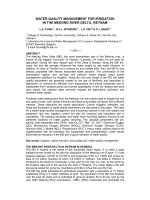Tài liệu Managing Telecom Invoices & Service Contracts in the Enterprise:A Guide to Best Practices doc
Bạn đang xem bản rút gọn của tài liệu. Xem và tải ngay bản đầy đủ của tài liệu tại đây (119.42 KB, 4 trang )
Managing Telecom
Invoices & Service
Contracts in the
Enterprise: A Guide
to Best Practices
1-800-COURSES
www.globalknowledge.com
Expert Reference Series of White Papers
Written and provided by
Introduction
As the landscape of telecommunications service providers and service offerings evolves, the financial impact of
change should be considered. Changes in service provider invoices that reflect administrative and financial
impact created by service changes contributes to the overall complexity of financial management. Each time a
service provider rolls out a new service offering, repackages existing technology or improves their service in
any way, the financial management points to monitor and report upon also change. Service evolution and
improvements are rapid in today's environment and these changes can negatively impact the budget unless
control is gained over cost and service change.
Telecom financial management is the practice of understanding,
relating and managing the cost of telecommu-
nications services. Financial management is supported by three key best practices disciplines:
1. Invoice & Service Inventory
2. Contract Inventory
3. Cost Control
These best practices support understanding and proactive management of telecom services and cost.
Best Practice: Invoice & Service Inventory
Financial management begins with understanding the services present in a telecom environment. Cost for the
services is represented on service provider invoices and these can be used to create a baseline for services and
associated cost. Creating an inventory of cost as the first step in inventory development, rather than creating a
physical service inventory, presents a clear picture of the total monthly cost of telecom service. Accurate or
inaccurate, invoices are the vehicles that document charges a service provider assesses for telecom services.
Invoiced service cost establishes a baseline of cost against which services and cost can be v
alidated for con
-
tractual and service accuracy.
In addition to invoices
,
service providers offer customer service records (CSRs),
circuit inventories, service con-
figuration inventories and equipment inventories which provide details about component charges that roll up
to overall invoice cost. These documents, in conjunction with existing inventory information about services
installed, allow customers to create a detailed inventory of the services installed and associated charges. This
baseline of services can then be validated against known service installations and compared against service
changes to refine the accuracy of the service inventory.
Timothy C. Colwell
Managing Telecom Invoices & Service Contracts
in the Enterprise: A Guide to Best Practices
Copyright ©2007 Global Knowledge T
raining LLC. All rights reserved.
Page 2
T
he best practice for invoice and service inventory development and management is:
• Create an inventory of telecom invoices
• Examine invoices and invoice source collateral, and create an inventory of services
• Identify cost components for services and attach costs to service inventory
• Confirm, correct, baseline and optimize
• Manage change affecting inventory
Best Practice: Contract Inventory
All telecom services procured from service providers are governed by terms and conditions. Legal provisions,
business provisions and pricing provisions are outlined in customer contracts or, in the case of non-term servic-
es, in tariffs and service guides. A comprehensive understanding of each term and condition of service enables
customers to validate service provider compliance with the provisions, as well as their own compliance with
the provisions.
T
elecommunications service contracts, tariffs and service guides are bulky and complex documents that require
detailed examination to glean specific details enabling contractual validation. To aid the validation process, a
contract inventory allows customers to extract specifics about each validation provision and proactively man-
age to each provision point.
The best practice for contract inventory development and management is:
• Create an inventory of telecom contracts
• Examine contracts, contract addenda, and tariffs/service guides, and populate contract inventory details
• Identify contract progress conditions and identify key life-cycle management dates
• Evaluate, monitor attainment and optimize
Best Practice: Cost Control
Cost control is the ongoing practice of validating financial and service accuracy, creating price performance
efficiencies and adapting to environmental and service changes
. Validating financial accuracy is supported with
invoice and contract inventories, as they contribute to the validation points of what is invoiced and what
should be invoiced.
Outside the practice of validating the accuracy of each month’s telecom charges, change management must be
considered. Telecom environments change — services are added, removed, changed or otherwise altered over
time. With each change, a financial impact is realized and the opportunity for changes to create invoice inaccu-
racy rises
.
V
alidating the expected cost of change is an additional activity within the cost control process
.
Changes in telecom technologies, technology packaging, service providers and applications can proactively be
affected in any environment to optimize service and financial efficiencies. The activity of service and cost opti-
mization is also an integral part of the cost control management best practice. As the telecom industry evolves,
new opportunities to create functional and financial impact arise. Altering existing service configurations,
obtaining new service contracts
,
and shaping services against organizational change allows telecom profes
-
sionals to optimize the cost of telecom within their organization.
Copyright ©2007 Global Knowledge T
raining LLC. All rights reserved.
Page 3
T
he best practice for cost control management is:
•Baseline services and usage
•Baseline costs for services and usage
•Correct errant billing
•Eliminate unnecessary services
•Trend inventory and usage
•Evaluate, optimize and manage change
Implementing these best practices creates positive financial impact for telecom professionals and their organi-
zations. As the industry changes, the importance of these best practice activities grows. Protecting the financial
integrity of telecom services creates organizational financial benefits and contributes to budgetary success.
Learn More
Learn more about how you can improve productivity, enhance efficiency, and sharpen your competitive edge.
V
isit our website for a list of Evotem courses that we offer.
For more information or to register, visit www.globalknowledge.com or call 1-800-COURSES to speak with a
sales representative.
Copyright ©2007 Global Knowledge T
raining LLC. All rights reserved.
Page 4









